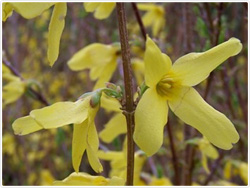Forsythia

Forsythia is a common sight in Rochester this time of year. While everything else is still bare, Forsythia seems to just glow with bright yellow flowers. Forsythia is a problem free shrub that is fast growing and can be planted almost anywhere and still be expected to bloom and prosper. The best bloom does come from being plant in full sun though. Forsythia works perfect as a large natural hedge since it can reach heights of 10 feet and grow just as wide. Their spring flowers are followed by green leaves that turn yellow in the fall. They can be pruned to keep a better form then the ‘bad-hair day’ look they sometime achieve over time. It’s best to tame them with the clippers right after they flower since they bloom on old wood. This way you won’t lose any of the wood that will flower next year by pruning to late in the season. They are also easily rejuvenated if you move into a house with an old neglected one. Prune out old wood (large, woody branches) at the base of the shrub. They will slowly sucker, sending up new branches. If you need to get drastic you can cut them all the way to the ground for rejuvenation, a practice known as coppicing.
While pruning for shape and rejuvenation is plausible for the Forsythia, trying to force it to stay smaller than it wants to leaves you with a distasteful sight in the landscape. They are not meant to be used as a small boxed formal shrub or hedge. They would at least like to get to heights of 7-8 feet and 4 feet wide. Make sure you prune at the proper time or you will get spotty, sparse flowering in spring. There are smaller cultivars that can be used as small ornamental shrubs in a foundation planting though. A typical cultivar you will see is ‘ Lynwood’ which reaches the usual 10 x 10’. ‘Spring Glory’ gets just as large yet blooms a little earlier then most cultivars. The flower petals seem a little more elongated too. A nice dwarf, compact grower reaching only 1 1/2’ by 5’ wide is Gold Tide™, great for foundation planting as it’s arching branches spread over the landscape quite attractively.
One of the best uses for Forsythia though is a cure for the winter blues. Early in the spring just as their flower buds begin to swell you can cut several stems and bring them in the house to force. Just place in a vase of water alone or mix with other cut flowers for an early spring bouquet, they will bloom right in the house. If everything is timed right they mix well with the cut stems of Pussy Willow and Daffodils. Then you have some bright flowers to enjoy inside when the outside world is still gray and drab and we’re all waiting until we can finally plant annuals!!
 |
One of the best uses for Forsythia though is a cure for the winter blues. Early in the spring just as their flower buds begin to swell you can cut several stems and bring them in the house to force. Just place in a vase of water alone or mix with other cut flowers for an early spring bouquet, they will bloom right in the house. If everything is timed right they mix well with the cut stems of Pussy Willow and Daffodils. Then you have some bright flowers to enjoy inside when the outside world is still gray and drab and we’re all waiting until we can finally plant annuals!!
April 4, 2010
|
View: 2697







